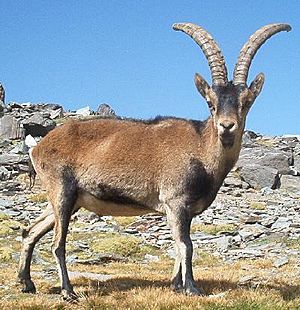Ungulate facts for kids
Ungulates are a group of mammals that mostly walk on the tips of their toes. These toes are usually covered by hard hooves. The word "ungulate" roughly means "hoofed animal."
Quick facts for kids Ungulate |
|
|---|---|
 |
|
| Donkey, Equus africanus | |
 |
|
| Spanish ibex (Capra pyrenaica) | |
| Scientific classification |
|
| Kingdom: | Animalia |
| Phylum: | Chordata |
| Class: | Mammalia |
| Clade: | Ferungulata |
| Clade: | Ungulata Linnaeus, 1766 |
| Orders and Clades | |
|
|
Contents
What Are Ungulates?
Most ungulates use their hooves to support their body weight as they move around. This helps them walk, run, and balance.
You might think of animals with hooves when you hear "ungulate." However, some animals like whales, dolphins, and porpoises are also considered ungulates, even though they don't have hooves. This is because scientists have found that these ocean animals are related to early even-toed ungulates. They evolved from land animals that once had hooves.
What Do Ungulates Eat?
Most ungulates are herbivores. This means they eat plants. Many of them have special bacteria in their stomachs. These bacteria help them digest tough plant materials like cellulose.
While most ungulates eat plants, some modern species are omnivores. For example, pigs eat both plants and meat. Long ago, some prehistoric ungulates, like the Mesonychia, were even carnivores and hunted other animals.
Types of Ungulates
Ungulates are divided into two main groups based on their toes:
Odd-Toed Ungulates
This group is called Perissodactyla. Animals in this group have an odd number of toes on each foot. The main toe is usually the largest and supports most of their weight.
Examples of odd-toed ungulates include:
Even-Toed Ungulates
This group is called Artiodactyla. Animals in this group have an even number of toes on each foot. Their weight is usually supported by two main toes.
Examples of even-toed ungulates include:
As mentioned before, cetaceans (whales, dolphins, porpoises) are also part of the even-toed ungulate group. Even though they live in water and don't have hooves, their ancestors were land-dwelling even-toed ungulates.
Images for kids
-
Skeleton of Ambulocetus natans, a stem whale
-
Pacific white-sided dolphin skeleton (missing pelvic bones), on exhibit at The Museum of Osteology, Oklahoma City, Oklahoma
-
Cloven hooves of Roe Deer (Capreolus capreolus), with dew claws
See also
 In Spanish: Ungulata para niños
In Spanish: Ungulata para niños











